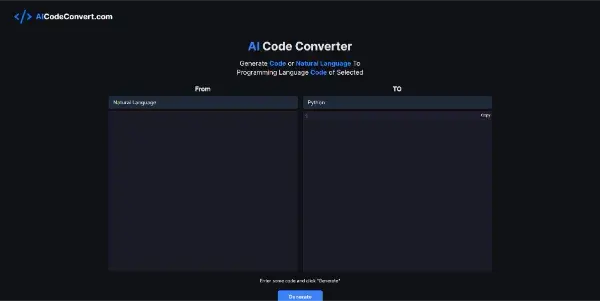AI Code Converter

An AI tool that converts code from one programming language to another. It supports a wide variety of languages: JavaScript, Python, etc.
AI Code Converter: Streamlining Cross-Language Development
The software development landscape is rich with diverse programming languages, each suited to specific tasks and paradigms. However, this diversity can present challenges when developers need to migrate codebases, integrate systems written in different languages, or simply explore alternative approaches. This is where an AI Code Converter, a powerful assistant code tool, becomes invaluable. This article explores its capabilities, applications, and comparative advantages.
What is an AI Code Converter?
An AI Code Converter is an innovative tool leveraging artificial intelligence to automate the process of translating code from one programming language to another. Unlike simple text-based translation, it understands the underlying logic and structure of the code, aiming to produce functionally equivalent code in the target language. It supports a wide array of popular programming languages, including but not limited to JavaScript, Python, C++, Java, and more. This allows developers to bridge the gap between different languages efficiently and effectively.
Main Features and Benefits
The core strength of an AI Code Converter lies in its ability to:
- Automate Code Translation: Eliminating the manual effort required for rewriting code in a new language, saving significant time and resources.
- Maintain Functionality: The AI strives to preserve the original code's functionality during the conversion process, minimizing errors and reducing debugging time.
- Support Multiple Languages: The broad language support allows developers to work seamlessly across various ecosystems.
- Improve Code Readability (Potentially): In some cases, the converted code might benefit from improved structure or style, enhancing readability compared to the original.
- Facilitate Code Migration: It simplifies the migration of legacy codebases to modern languages or frameworks.
- Aid Learning: Developers can use it to learn new languages by seeing how code is implemented in a different syntax.
Use Cases and Applications
The practical applications of an AI Code Converter are numerous and span various aspects of software development:
- Legacy Code Modernization: Updating outdated systems by converting code to more maintainable and efficient languages.
- Cross-Platform Development: Building applications that function across different platforms by translating code to suitable target languages.
- Integration of Systems: Seamlessly combining systems built with different programming languages.
- Rapid Prototyping: Quickly exploring different language implementations of an algorithm or feature.
- Education and Learning: Assisting developers in learning new programming languages by seeing direct translations.
- Open-Source Contributions: Converting code from one language to another to broaden its accessibility and use.
Comparison to Similar Tools
Several tools offer code conversion capabilities, but AI-powered converters offer key advantages:
- Accuracy: AI algorithms are generally more accurate than simpler, rule-based translation methods.
- Handling Complexity: AI excels in handling complex code structures and logic that might stump simpler tools.
- Adaptability: AI-based systems can learn and adapt to new language features and idioms over time.
However, it is crucial to note that while AI Code Converters significantly improve the process, manual review and testing of the converted code are always recommended to ensure accuracy and functionality.
Pricing Information
Currently, the AI Code Converter is offered free of charge. This makes it an accessible and valuable tool for developers of all levels and budgets. However, future pricing models may be introduced.
Conclusion
The AI Code Converter represents a significant step forward in software development, streamlining cross-language development and reducing the burden of manual code translation. Its free accessibility and powerful capabilities make it a valuable asset for developers seeking to improve efficiency, explore new languages, and modernize existing codebases. While manual verification remains essential, the tool offers considerable potential to revolutionize how developers interact with diverse programming languages.